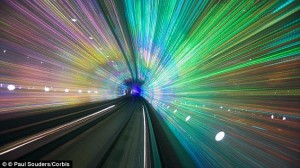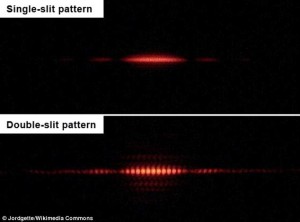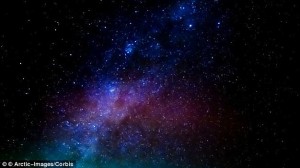Quantum Physics Proves That There IS an Afterlife, Claims Scientist
SCIENCE - SPIRITUALITY, 18 Nov 2013
Victoria Woollaston – Daily Mail
- Robert Lanza claims the theory of biocentrism says death is an illusion
- He said life creates the universe, and not the other way round
- This means space and time don’t exist in the linear fashion we think it does
- He uses the famous double-split experiment to illustrate his point
- And if space and time aren’t linear, then death can’t exist in ‘any real sense’ either
Most scientists would probably say that the concept of an afterlife is either nonsense, or at the very least unprovable.
Yet one expert claims he has evidence to confirm an existence beyond the grave – and it lies in quantum physics.
Professor Robert Lanza claims the theory of biocentrism teaches that death as we know it is an illusion created by our consciousness.

Professor Robert Lanza claims the theory of biocentrism teaches death as we know it is an illusion. He believes our consciousness creates the universe, and not the other way round, and once we accept that space and time are ‘tools of our minds’, death can’t exist in ‘any real sense’ either.
‘We think life is just the activity of carbon and an admixture of molecules – we live a while and then rot into the ground,’ said the scientist on his website.
Lanza, from Wake Forest University School of Medicine in North Carolina, continued that as humans we believe in death because ‘we’ve been taught we die’, or more specifically, our consciousness associates life with bodies and we know that bodies die.
His theory of biocentrism, however, explains that death may not be as terminal as we think it is.
Biocentrism is classed as the theory of everything and comes from the Greek for ‘life centre’.
It is the believe that life and biology are central to reality and that life creates the universe, not the other way round.
This suggests a person’s consciousness determines the shape and size of objects in the universe.
Lanza uses the example of the way we perceive the world around us. A person sees a blue sky, and is told that the colour they are seeing is blue, but the cells in a person’s brain could be changed to make the sky look green or red.
‘Bottom line: What you see could not be present without your consciousness,’ explained Lanza. ‘Our consciousness makes sense of the world.’
By looking at the universe from a biocentric’s point of view, this also means space and time don’t behave in the hard and fast ways our consciousness tell us it does. In summary, space and time are ‘simply tools of our mind.’
Once this theory about space and time being mental constructs is accepted, it means death and the idea of immortality exist in a world without spatial or linear boundaries.
Similarly, theoretical physicists believe there is infinite number of universes with different variations of people, and situations, taking place simultaneously.

Lanza cites the double-slit test, pictured, to backup his claims. When scientists watch a particle pass through two slits, the particle goes through one slit or the other. If a person doesn’t watch it, it acts like a wave and can go through both slits simultaneously. This means its behaviour changes based on a person’s perception.
Lanza added that everything which can possibly happen is occurring at some point across these multiverses and this means death can’t exist in ‘any real sense’ either.
Lanza, instead, said that when we die our life becomes a ‘perennial flower that returns to bloom in the multiverse.’
He continued: ‘Life is an adventure that transcends our ordinary linear way of thinking. When we die, we do so not in the random billiard-ball-matrix but in the inescapable-life-matrix.’
Lanza cited the famous double-slit experiment to backup his claims.
In the experiment, when scientists watch a particle pass through two slits in a barrier, the particle behaves like a bullet and goes through one slit or the other.
Yet if a person doesn’t watch the particle, it acts like a wave, This means it can go through both slits at the same time.
This demonstrates that matter and energy can display characteristics of both waves and particles, and that behaviour of the particle changes based on a person’s perception and consciousness.
LANZA’S THEORY OF BIOCENTRISM AND THE AFTERLIFE
Biocentrism is classed as the Theory of Everything and comes from the Greek for ‘life centre’. It is the belief that life and biology are central to reality and that life creates the universe, not the other way round.
Lanza uses the example of the way we perceive the world around us.
A person sees a blue sky, and is told that the colour they are seeing is blue, but the cells in a person’s brain could be changed to make the sky look green or red.
Our consciousness makes sense of the world, and can be altered to change this interpretation.
By looking at the universe from a biocentric’s point of view, this also means space and time don’t behave in the hard and fast ways our consciousness tell us it does.
In summary, space and time are ‘simply tools of our mind.’
Once this theory about space and time being mental constructs is accepted, it means death and the idea of immortality exist in a world without spatial or linear boundaries.
Theoretical physicists believe that there is infinite number of universes with different variations of people, and situations taking place, simultaneously.
Lanza added that everything which can possibly happen is occurring at some point across these multiverses and this means death can’t exist in ‘any real sense’ either.
Lanza, instead, said that when we die our life becomes a ‘perennial flower that returns to bloom in the multiverse.’
HOW THE DOUBLE-SLIT EXPERIMENT SUPPORTS LANZA’S THEORY
In the experiment, when scientists watch a particle pass through two slits in a barrier, the particle behaves like a bullet and goes through one slit or the other.
Yet if a person doesn’t watch the particle, it acts like a wave.
This means it can go through both slits at the same time.
This demonstrates that matter and energy can display characteristics of both waves and particles, and that the behaviour of the particle changes based on a person’s perception and consciousness.
Lanza’s full theory is explained in his book Biocentrism: How Life and Consciousness are the Keys to Understanding the True Nature of the Universe.
Go to Original – dailymail.co.uk
DISCLAIMER: The statements, views and opinions expressed in pieces republished here are solely those of the authors and do not necessarily represent those of TMS. In accordance with title 17 U.S.C. section 107, this material is distributed without profit to those who have expressed a prior interest in receiving the included information for research and educational purposes. TMS has no affiliation whatsoever with the originator of this article nor is TMS endorsed or sponsored by the originator. “GO TO ORIGINAL” links are provided as a convenience to our readers and allow for verification of authenticity. However, as originating pages are often updated by their originating host sites, the versions posted may not match the versions our readers view when clicking the “GO TO ORIGINAL” links. This site contains copyrighted material the use of which has not always been specifically authorized by the copyright owner. We are making such material available in our efforts to advance understanding of environmental, political, human rights, economic, democracy, scientific, and social justice issues, etc. We believe this constitutes a ‘fair use’ of any such copyrighted material as provided for in section 107 of the US Copyright Law. In accordance with Title 17 U.S.C. Section 107, the material on this site is distributed without profit to those who have expressed a prior interest in receiving the included information for research and educational purposes. For more information go to: http://www.law.cornell.edu/uscode/17/107.shtml. If you wish to use copyrighted material from this site for purposes of your own that go beyond ‘fair use’, you must obtain permission from the copyright owner.
Read more
Click here to go to the current weekly digest or pick another article:
SCIENCE - SPIRITUALITY:
